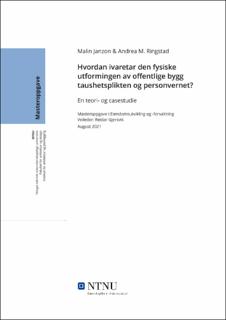| dc.contributor.advisor | Gjersvik, Reidar | |
| dc.contributor.author | Janzon, Malin | |
| dc.contributor.author | Ringstad, Andrea | |
| dc.date.accessioned | 2022-05-04T17:19:20Z | |
| dc.date.available | 2022-05-04T17:19:20Z | |
| dc.date.issued | 2021 | |
| dc.identifier | no.ntnu:inspera:83437241:35579996 | |
| dc.identifier.uri | https://hdl.handle.net/11250/2994246 | |
| dc.description.abstract | Formålet med oppgaven er å undersøke hvordan den fysiske utformingen av offentlige bygg ivaretar taushetsplikten og personvernet.
Arealeffektivisering og overgang fra tradisjonelle cellekontorer til åpne landskap og aktivitetsbaserte arbeidsplasser i ulike utforminger, har medført nye fordeler og ulemper for ansatte. Det er gjennomført forskning på hvilke konsekvenser de nye arbeidsplasskonseptene har hatt for muligheten til å arbeide effektivt, uforstyrret og konsentrert. Det har også vært fokus på hvordan ansattes trivsel og helse har blitt påvirket av de nye konseptene.
Vi ønsker med vår masteroppgave å undersøke hvordan et utvalg kontorbygg ivaretar lovbestemt taushetsplikt og personvern, samt å finne tiltak for å bedre ivaretagelsen. Vi har begrenset undersøkelsen til kun å omfatte offentlige bygg, som også har en mottaksfunksjon for klienter/brukere. Vi har som hensikt at resultatet kan være med på å utvikle en arbeidsplassnorm for organisasjoner som håndterer slik informasjon herunder krav til arbeidsplass relatert areal.
Følgende forskningsspørsmål er undersøkt:
• Er de ansattes lovbestemte taushetsplikt ivaretatt slik arbeidsplassene er innrettet i dag?
• Hvilke fysiske, tekniske og organisatoriske tiltak kan forbedre ivaretagelsen av taushetsplikten?
• Er arbeidsplasser som håndterer taushetsbelagte opplysninger mer arealkrevende enn arbeidsplasser som ikke håndterer slik informasjon?
Metodene som er benyttet i oppgaven er litteraturstudie, dokumentasjonsstudie, casestudier, dybdeintervjuer, strukturerte gruppeintervjuer og digitale gåturer.
Det teoretisk rammeverket er litteratur fra pensum ved masterstudiet, rapporter, artikler og masteroppgaver og juridisk litteratur om emnet taushetsplikt.
Funnene viser at den fysiske utformingen av bygget sammen med tekniske løsninger og organisatoriske forhold påvirker hverandre og er alle viktige faktorer for ivaretakelsen. Hvilket kontorkonsept som er valgt har ingen avgjørende betydning for god ivaretakelse. Funnene viser også at av det ikke nødvendigvis er en sammenheng mellom arealbruk og god ivaretakelse av taushetsplikten. En suksessfaktor er at det gjennomføres en grundig prosess der taushetsplikten er en faktor, både i programmeringen av nye bygg, og i den løpende driften. | |
| dc.description.abstract | The purpose of the thesis is to investigate how the physical design of public office-buildings safeguards the duty of confidentiality and privacy imposed on employees by the legislature.
Space efficiency and the transition from traditional cell-offices to open landscapes and activity-based workplaces, in various designs; have led to new advantages and disadvantages for employees. The consequences of the new workplace concepts for the opportunity to work efficiently, undisturbed and concentrated, has been the focus for research and debate. Also, in which regard the well-being and health og the employees have been affected.
With our master's thesis, we want to investigate how a selection of office buildings fulfills the statutory duty of confidentiality and privacy, as well as find measures for improvement. We have limited the survey to only public buildings, which also have a reception function for clients / users. We intend that the result can help to develop a workplace norm for organizations that handle such information, including requirements for workplace-related area.
The following research questions have been investigated:
• Are the employees' statutory duty of confidentiality sufficient as the workplaces are arranged today?
• What physical, technical, and organizational measures can improve compliance with the imposed duty?
• Are workplaces that handle confidential information more space-intensive than workplaces that do not handle such information?
The methods used in the thesis are literature study, documentation study, case studies, in-depth interviews, structured group interviews and digital walks.
The theoretical framework is literature from the syllabus for the master's program, reports, articles and master's theses and legal literature on the subject of confidentiality.
The findings show that the physical design of the building together with technical solutions and organizational conditions affect each other and are all-important factors to consider. Which office concept is chosen has no decisive significance. The findings also show that there is not necessarily a connection between land use and good safeguarding of the duty of confidentiality. A success factor is that a thorough process is carried out where the duty of confidentiality is a factor, both in the programming of new buildings, and in the ongoing operation. | |
| dc.language | nob | |
| dc.publisher | NTNU | |
| dc.title | Hvordan ivaretar den fysiske utformingen av offentlige bygg taushetsplikten og personvernet? | |
| dc.type | Master thesis | |
